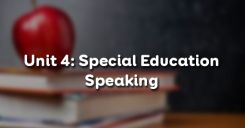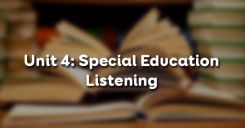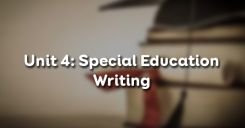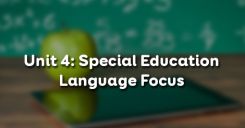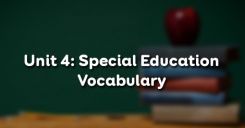Bài học Reading Unit 4 tiếng Anh lớp 10 hướng dẫn các em đọc hiểu nội dung bài về chương trình giáo dục đặc biệt cho học sinh khuyết tật.
Tóm tắt bài
1. Before Your Read Unit 4 Lớp 10
- Make a list or the activities you do every day. Then ask your partner which ones he/she thinks would be difficult for blind and deaf people. (Lập danh sách những hoạt động em làm mỗi ngày. Sau đó hỏi bạn học những hoạt động nào bạn ấy nghĩ sẽ khó khăn cho những người khiếm thị và khiếm thính.)
Guide to answer
| in the morning |
in the afternoon |
in the evening |
| brush teeth |
take a nap |
watch TV, about half an hour |
| do exercise |
do my homework and exercise |
learn lessons/do exercises |
| take a bath |
play sports with friends |
go to bed, at about 10:30 |
| have breakfast |
go to school |
Work with a partner. Look at the Braille Alphabet. Then work out the message that follows. (Làm việc với bạn học. Nhìn vào Bảng chữ cái Braille. Sau đó tìm ra thông điệp kèm theo.)
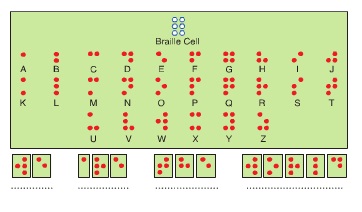
Guide to answer
WE ARE THE WORLD
2. While You Read Unit 4 Lớp 10
Read the passage and then do the tasks that follow. (Đọc đoạn văn và sau đó làm các bài tập theo sau.)
2.1. Unit 4 Lớp 10 Reading Task 1
The words in A appear in the reading passage. Match them with their definitions in B. (Các từ ở A xuất hiện trong bài đọc. Ghép chúng với những định nghĩa ở B.)
| A | B |
|
1. disabled 2. mentally retarded 3. time - consuming 4. demonstration 5. gradually |
a. taking or needing a lot of time b. an act of showing or explaning how to do something c. unable to use a part of the body in the normal way d. slowly,over a long period of time e. less mentally developed than normal |
Guide to answer
1 - c
2 - e
3 - a
4 - b
5 - d
2.2. Unit 4 Lớp 10 Reading Task 2
Read the passage again and complete the following sentences by circling the corresponding letter A, B, C or D. (Đọc lại đoạn văn và hoàn thành các câu sau bằng cách khoanh tròn chữ cái A, B, C hoặc D tương ứng.)
1. Thuy's class is different from other classes because the children_____.
A. are from large families
B. are less mentally developed
C. love Maths very much
D. are disabled
2. At first the parents were ______ the idea of sending their children to the special class.
A. interested in C. satisfied with
B. opposed to D. worried about
3. It can be inferred from the second paragraph of the readinf passage that there has been_______.
A. a change in the parents' attitude towards the class
B. a lot of protest from the parents against the class
C. a feeling of doubt in the teacher's ability
D. a belief in the parents' opposition
4. The write describes how Thuy teaches the children to add and subtract in order to prove that _______.
A. the children like Maths
B. the teacher is proud of her work
C. the teaching work takes time
D. adding and subtracting are important
5. The writer's attitude towards Thuy's work in the passage can be described as __________.
A. humorous B. angry C. suspicious D. admiring
Guide to answer
1. D
2. B
3. A
4. C
5. D
3. After You Read Unit 4 Lớp 10
- Fill in each of the blanks of the summary below with a suitable word from the reading passage. (Điền mỗi chỗ trống của bài tóm tắt dưới đây với từ thích hợp từ bài đọc.)
Twenly-five (1) _________ children have the chance of learning how to (2) _____ and (3) ______ thanks to the (4) ______ of a young teacher, Pham Thu Thuy.
Although her idea, at first, met with (5) ______ from the parents of the disabled children, more children attended her class later. The touching work in the special class is (6) _________.
For example, in a (7) _____ lesson, the teacher has to use her (8) ________ and (9) ______ to teach the children how to add and subtract. The children are now (10) _______ and happy.
Guide to answer
Twenly-five (1) disabled children have the chance of learning how to (2) read and (3) write thanks to the (4) efforts of a young teacher, Pham Thu Thuy.
Although her idea, at first, met with (5) opposition from the parents of the disabled children, more children attended her class later. The touching work in the special class is (6) time-consuming.
For example, in a (7) Maths lesson, the teacher has to use her (8) arms and (9) fingers to teach the children how to add and subtract. The children are now (10) proud and happy.
- Dịch nghĩa
25 đứa trẻ khuyết tật có cơ hội để học cách đọc và viết lời cảm ơn tới sự cố gắng của một giáo viên trẻ, cô Phạm Thu Thủy.
Theo như lời cô giáo trẻ, dẫu cho lúc đầu có gặp sự phản đối của cha mẹ những đứa trẻ khuyết tật này, nhưng sau đó ngày càng nhiều trẻ đã đến học ở lớp của cô. Công việc dạy học ở lớp học đặc biệt này rất tốn thời gian.
Chẳng hạn như trong giờ Toán học, cô giáo phải sử dụng đôi bàn tay và các ngón tay để dạy bọn trẻ cách cộng và trừ. Bọn trẻ bây giờ thấy tự hào và hạnh phúc.
4. Bài dịch Reading Unit 4 Lớp 10
Một giáo viên ở lớp học đặc biệt
Như các giáo viên khác, Phạm Thu Thủy yêu nghề dạy học. Tuy nhiên lớp của cô khác hẳn các lớp khác. Hai mươi lăm học sinh đang học đọc và viết trong lớp là trẻ khuyết tật. Một số em bị câm, một số em bị điếc và các em khác chậm phát triển trí tuệ. Hầu hết, gia đình các em là những gia đình nghèo khó khiến các em không thể học hành tới nơi tới chốn.
Thoạt đầu ba mẹ các em rất phản đối việc cho con đi học. Họ vẫn tin là con họ chẳng thể học được điều gì. Trong tuần lễ đầu tiên chỉ có năm em đến lớp. Dần dần bọn trẻ đi học đông hơn. Cha mẹ chúng nhận ra rằng cô giáo trẻ đã rất nỗ lực để giúp trẻ em nghèo.
Nhìn cô Thủy đứng lớp, người ta có thể thấy được công việc của cô tốn nhiều thời gian thế nào. Trong giờ học Toán, cô đưa cả hai cánh tay ra, giơ lên từng ngón một cho đến khi đủ cả mười ngón. Sau đó cô cụp từng ngón tay lại. Cô tiếp tục làm như thế cho đến khi bọn trẻ nhận ra rằng chúng đã học được cách cộng trừ. Bọn trẻ có lý do để tự hào về nỗ lực của mình. Các em biết rằng một thế giới đang mở ra cho các em.
Bài tập minh họa
Read the passage below carefully, and then decide whether the statements are true (T), false (F) or not given (N)
Education of students who are hard of hearing or deaf may involve the use of powerful amplification devices, such as hearing aids, or it may use captions (printed words that appear on a television screen or computer monitor). Many deaf or hard of hearing students learn sign language, an organized system of gestures for communication. Others learn to speechread (lipread), a method of interpreting speech by “reading” the patterns of a person’s mouth as he or she speaks. Some deaf students receive cochlear implants, which are receivers surgically implanted behind the ear and connected to electrodes placed in the cochlea of the inner ear, enabling individuals to hear sounds to a varying degree.
Gifted children are often moved through the regular school curriculum at a faster pace than their peers. Some children with exceptionally high ability in a particular subject area may be allowed to reduce the time they spend in their other subjects to permit more time to focus on challenging content in their specialty. A high school student who is particularly gifted in math, for example, may attend advanced math classes at a local college rather than music classes at the high school. Some gifted students may also skip grades or they may enter kindergarten, high school, or college at an early age.
1/ Hearing aid is a device worn inside or next to the ear by people who cannot hear well in order to help them to hear better.
2/ Just few deaf or hard of hearing students learn sign language.
3/ Several dumb students receive cochlear implants.
4/ The first paragraph is about deaf and hard of hearing students.
5/ There are many deaf students in the United States of America.
6/ Gifted children often find it easier to move through the regular school curriculum at a faster pace than their friends.
7/ All the children have to spend equal time in their study in these schools.
8/ A gifted high school student may attend any classes at a local college that he or she wants to.
9/ Education in foreign countries is very good.
10/ The second paragraph is about gifted students.
Key
|
1 |
2 |
3 |
4 |
5 |
6 |
7 |
8 |
9 |
10 |
|
T |
F |
F |
T |
N |
I |
F |
F |
N |
T |
Bài tập trắc nghiệm Reading Unit 4 Lớp 10
Trên đây là nội dung bài hoc Reading Unit 4 Lớp 10 - Special Education, để củng cố và nâng cao kỹ năng đọc hiểu mời các em tham gia Trắc nghiệm Unit 4 lớp 10 Reading.
-
Câu 1: Choose the one option - a, b, c or d - that best fits each of the num bared blank
Louis Braille was born in 1309 (1)...................Coupvray. He was a French (2) ..................of the blind. He (3).............. was blind from the age of three, and in 1818 he went to the National Institute (4).................. the Young Blind in Paris. Soon showing marked (5)......................... in both science and music, he became famous in Paris (6)................... an organist and violoncellist. In 1826 Braille began teaching the blind in the (7)................ . Braille is known for his idea of (8).................. the Briberies. Point writing (9)...................... of embossed dots and dashes on cardboard;. the Braille system (10).................... from it is used successfully today, in slightly modified form, and in many countries.
(1) ..................
- A. on
- B. at
- C. in
- D. of
-
Câu 2:
(2) ..................
- A. designer
- B. doctor
- C. teacher
- D. lawyer
-
Câu 3:
(3) ..................
- A. who
- B. whom
- C. himself
- D. for himself
Câu 4-10: Mời các em đăng nhập xem tiếp nội dung và thi thử Online để củng cố kiến thức về bài học này nhé!
Hỏi đáp Reading Unit 4 Lớp 10
Trong quá trình học bài và làm bài tập thực hành nếu có điểm gì thắc mắc các em có thể đặt câu hỏi trong mục Hỏi đáp để được sự hỗ trợ từ cộng đồng HỌC247. Chúc các em học tốt!
-- Mod Tiếng Anh 10 HỌC247






